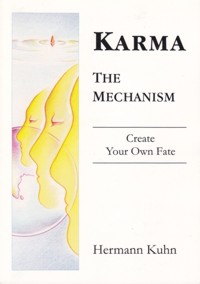
Mithyadarshanaviratipramadakasayayoga bandhahetavah (1)
Five factors attach karmic mechanisms to our consciousness:
- misunderstanding how this world really functions (mithyadarsana)
- our tendency to remain in this state of delusion, error and flawed concepts (though we are offered opportunities to end this state) (avirati)
- carelessness in our thinking, speech and action (pramada)
- unchecked negative emotions (ksaya)
- the activities of our body, speech and mind (yoga). (1)
Misunderstanding how this world really functions is caused by five factors:
1 - One-sided perspective
We see the world (beings, things, situations, events, concepts etc.) from one particular angle only and ignore its abundance and many-faceted diversity.
When our mind or heart is captured by a one-sided perspective, we project one particular model onto everything we experience. This one model usually excludes all other viewpoints or prevents us from recognizing their validity. Though events may happen right before our eyes that totally conflict with our cherished model, we are incapable of learning from them.[32]
One-sided perspectives lock our understanding into narrow boundaries. They prevent the many-faceted and colorful abundance of this world from reaching and expanding our awareness.
2 - Wrong concepts
We project concepts and models onto this world that do not correspond with reality.
Concepts based on flawed assumptions often appear surprisingly logical. We arbitrarily use the logic particular to a flawed model to justify our emotional preference for one specific limiting concept before other, more comprehensive ones.
As long as our thinking remains trapped in such logic, it is impossible to discover the flaws in its construction. Without questioning the model from an outside point of view, we limit our awareness to the limits of the erroneous concept.
As long as we firmly hold on to flawed ideas, we are subject to the psychological effect that we - consciously or subconsciously - check all experiences and events whether they fit into our cherished model. All facts that do not agree with the model are ignored, interpreted as unimportant, forgotten or not even perceived. Unfortunately this perpetuates our attachment to erroneous ideas.[33]
3 - Doubt, skepticism, hesitation
Even though we obtain a certain degree of (temporary) insight into the real mechanisms of this world, we allow this impulse to pass. We give it no chance to influence our life.
Both mechanisms prevent the expansion of our known circle of life.
4 - Pointless generalization
We carelessly or foolishly project ideas and concepts onto areas for which they are not valid.
Pointless generalization disregards the individual components of life. It always is a sign of a indifference and disinterest in our own life as well. This factor blocks a differentiated perception of events and thereby hinder us to access more detailed and comprehensive cognition.
5 - Ignorance
is an inability to recognize the path that leads towards inner growth and the expansion of our understanding. Ignorance is be caused by two factors:
There are four general categories of flawed teachings:
Our tendency to remain in this state of delusion, error and flawed concepts (even though we are offered opportunities to end this state).
This usually manifests in form of apathy or laziness. Though we have some (temporary) insight into the true functioning of this world and also feel an impulse to examine our habitual behavior or to try out new types of action, we are too lazy, complacent and set in our accustomed ways to follow this impulse. This tendency also manifests as
- a general indifference whether our actions hurt other beings or restrict their joy of life, or
- an unchecked attachment to sense pleasures
Carelessness in action, speech and thinking
expresses basic indifference towards the mechanisms that prolong our chain of incarnations (see 'Attraction to Karma', sutra 5). It obstructs inner growth because we regard any improvement of our present state of existence as unimportant.
Inner growth, insight and more advanced stages of development become only accessible when we commit the best of our attention, energy and abilities towards this goal.
Carelessness towards other beings or objects always also indicates a lack of respect towards our own life.
Unchecked negative emotions
senselessly waste our life's energy on rage (anger), arrogance (pride), deception or greed.
These four main negative emotions selfishly focus all our strength on our personal field of experience only. They confine us to the limits of our present situation and thus prevent us from expanding our scope of life. As long as we are unwilling to stop these tendencies, we block all inner growth.
The activities of our body, speech and mind
and their effect on karma are described in the initial sutras of 'Attraction to Karma'.
All our actions confront us with karmic mechanisms. Karma is actually the factor that enables us to act within the context of the material world in the first place. Whether this confrontation is only short-lived or will cause deeper and longer-lasting attachments to particular themes of life, depends entirely on our behavior, intention and emotional attitude at the time of action:
These five factors bind karma to our consciousness. Each factor can cause this attachment by itself. The strength of the bond, its duration, its dissolution, and how karma will manifest when it activates, is the theme of this chapter.
As long as we remain in the first stage of development (guna-sthana) all five factors are active.
In stage 2 and 3 our misunderstanding how this world functions becomes inactive for a short time.
In stage 4 all misunderstanding how the world functions is dissolved. Only the other four factors remain active.
In stage 5 and 6 our tendency to remain in a state of delusion is removed. Still active are carelessness, mild forms of negative emotions and the three types of activities of body, speech and mind.
In stage 7, 8, 9 and 10 carelessness is removed. Still active are subtle forms of negative emotions and the three types of activities.
In stage 11, 12 and 13 only the three types of activities are active.
In the fourteenth stage of development karma ceases to bind us.
This erects a high barrier before the exploration and understanding of intuitive phenomena. When we choose to see our world from a science-oriented, one-sided, materialistic point of view, we block all access to our rich inner dimensions.
For those who believe in this odd, speculative idea, all search for a purpose of life beyond this unproven model is blocked.
 Hermann Kuhn
Hermann Kuhn
